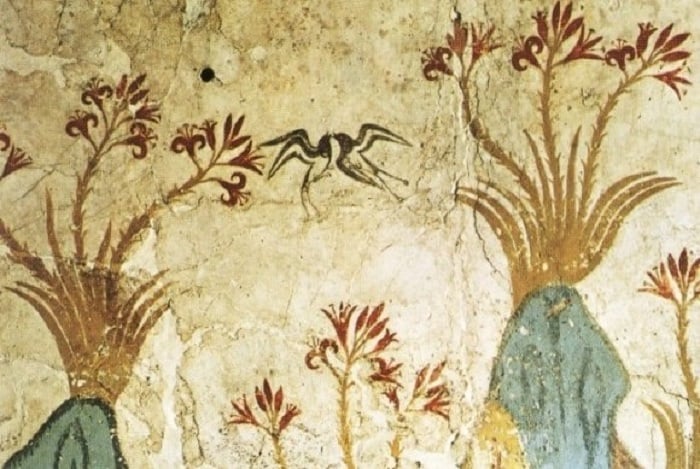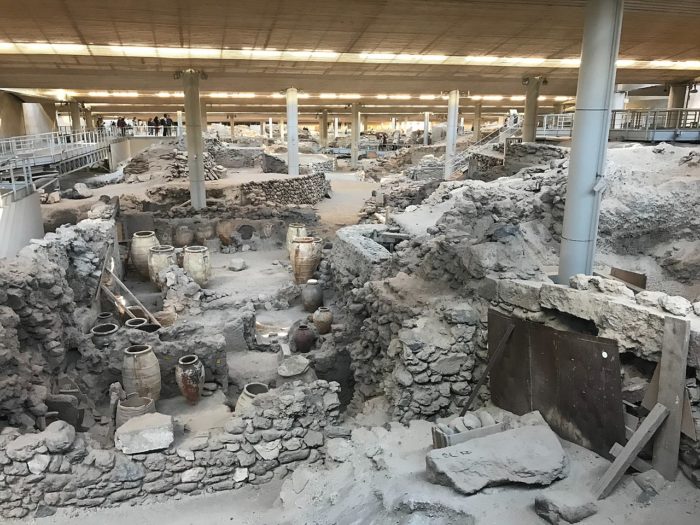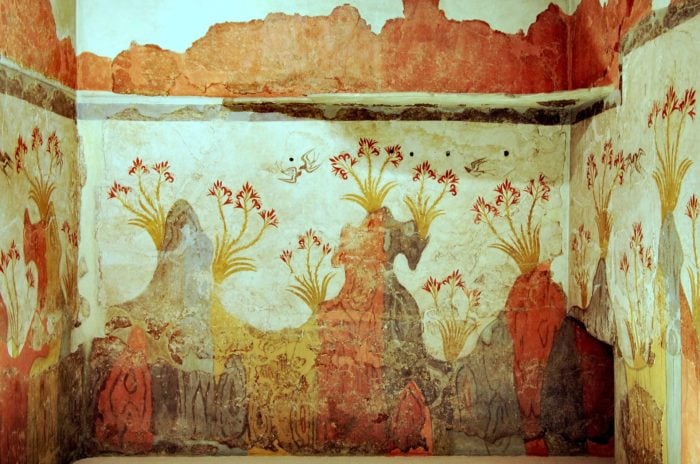
The Spring Fresco found at the Late Bronze Age site of Akrotiri in Santorini is considered to be the first painting of a nature scene in European art history.
Also called the Fresco of the Room of the Lilies, found at the Delta Complex of the site, the Spring Fresco has been a great subject of discussion among archaeologists and art historians.
The mural, which covers three walls of the small room, has raised questions over the room’s purpose.
More importantly, the iconographic meaning of the images has puzzled researchers and scholars, leading to divided opinions on the flying swallows’ behavior.
The importance of Akrotiri of Santorini
The discovery of the Spring Fresco in Akrotiri reveals a great deal about the Middle and Early Late Bronze Age (20th-17th century BC) Greek civilization.
Akrotiri was one of the most important centers in the Aegean in prehistoric times. The first settlements in Akrotiri date from the Late Neolithic Age, at least from the 4th millennium BC.
During the Early Bronze Age (3rd millennium BC) there was a settlement in Akrotiri. During the Middle and Early Late Bronze Age the settlement expanded and became one of the most important urban centers and ports in the Aegean.
Its large area of about 200 acres, its excellent urban organization, its very advanced sewage and plumbing network, its ornate high-rise buildings with exquisite mural decoration, rich furniture and household items, testify to its advanced development, as excavation finds show.

The various imported products found inside the buildings show the breadth of the network of Akrotiri’s cultural connections. The city had close relations with Minoan Crete but was also in contact with Mainland Greece, the Dodecanese, Cyprus, Syria and Egypt.
Life in the city ended abruptly in the last quarter of the 17th century BC, when its inhabitants were forced to abandon it due to devastating earthquakes.
The eruption of the volcano that followed covered the city with lava and ash, creating a protective shield that left buildings and their contents intact, as in Pompeii.
The frescoes in Akrotiri are especially important for the study of Minoan art because they are far better preserved than those that were already known from Knossos and other sites on Crete.
Scholars suggest that the destruction of Akrotiri possibly inspired Plato to write the story of Atlantis.
The questions around the Santorini Spring Fresco
The Spring Fresco, like all Minoan wall paintings, has vibrant colors, ranging from reds and oranges, to black, blue and purple, and even white.
The paints were made from crushed mineral powder and painted on to a wet or dry lime plaster, applied to the wall.
A chemical process known as carbonation takes place when the plaster dries and the lime reacts with carbon dioxide in the air, fixing the pigment to the plaster.

The Akrotiri frescoes depict the natural world with animals and plants, or fish and seascapes.
Also, mammals and mythological creatures were painted there, including bulls, antelopes and monkeys, ducks and swallows, as well as griffins.
Fragmentary evidence of frescoes has been found in many different types of buildings in Akrotiri, suggesting that this form of decoration was not restricted to the wealthy, but was enjoyed by all.
Academics are puzzled over the birds in the Spring Fresco, however. Are the swallows courting, or their behavior is more sinister?
Are they fighting, or are they playing? The lilies on the wall painting and the colorful rocks lead the viewer to think of several other interpretations.
Does it symbolize nature’s cycle as the birds feed off the lilies? Or is it the rebirth of nature in the Spring, with the swallows rejoicing and playing happily?
Regardless of the actual meaning of the birds, the Spring Fresco remains the first nature scene in European art history.
See all the latest news from Greece and the world at Greekreporter.com. Contact our newsroom to report an update or send your story, photos and videos. Follow GR on Google News and subscribe here to our daily email!



